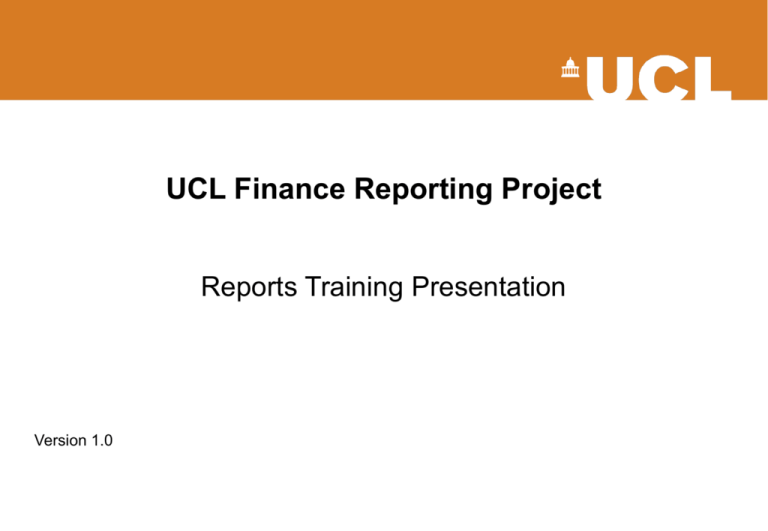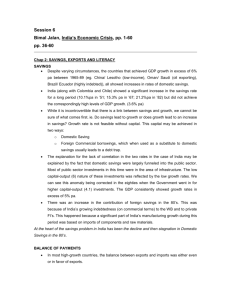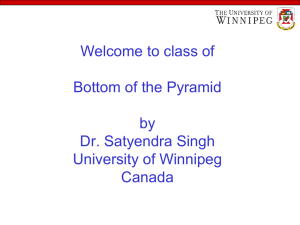BOP Report Training Presentation
advertisement

UCL Finance Reporting Project Reports Training Presentation Version 1.0 UCL Finance Reporting Project BOP Reports Training Session Presenters: Ian Davis, Senior Management Accountant Jonathan Thompson, Project Manager Session Duration: 2 ¾ Hours Location: Training Room, Second Floor UCL Union Huntley Street UCL Finance Reporting Project BOP Reports Training Name School/Department Ross James BEAMS Syed Murshed BEAMS Andrew Brown Co Ly CSS Asif Bhatti CSS Nadir Chowdery Robert Ebsworth Mystery guest UCL Finance Reporting Project BOP Rollout Training Course structure: • Overview of Financial Reporting Project and Reporting Process. • Intro to Business Objects Planning Reporting accessing reports in the BOP system. • Understanding the BOP Data - that is available for use in reports • How to write BOP reports - hands-on practice and report building exercises in BOP • Session wrap-up • Helpdesk, Feedback UCL Finance Reporting Project Annual Reporting Calendar AUG SEPT Quarterly Process Reporting NOV Prepare End Q4 Adjts Finalise Year End Accounts JAN FEB MAR Q1 PE APR MAY JUN Q3 Forecast 5+7 2+10 Prepare YE Accounts DEC Q2 Forecast Q1 Forecast Forecast Period End OCT Example 8+4 Q2 PE Q3 PE Update of Actuals from FIS Budget Process Prepare target setting Budget Consolidate & Finalise Targets Update detailed Budgets JUL UCL Finance Reporting Project Standard Data Update Processes Impact on reporting data STANDARD QUARTER PERIOD Start of New Quarter MONTH 3 OF QUARTER PERIOD QUARTERLY FORECAST UPDATE Depts Entry Depts In Year Adjustments Faculties Workbooks Allocations & Reserves MTH 1 MTH 2 WEEK 1 WEEK2 WEEK 3 WEEK 4 MTH 1 MTH 2 Departments enter forecasts, allocation, reserve adjustments Departments update forecasts, allocations, reserve adjustments on individual accounts as required Departments update forecasts, allocations, reserve adjustments on individual accounts as required Finance/Faculties enter allocations, transfers of reserves for upload to department accounts - Consider when the report will be run and which data should be included within it - Approved or unapproved data? - Include IYA and AR adjustments? Current BOP Reporting What information do I want? - Reports and Print Styles • Print styles are used to print out parts of a workbook – They are accessed from the workbook – They are limited to data within the current workbook – They can have a limited number of options/parameters to select or limit data shown • Reports are available to report on data across the database at various levels – The data shown can be limited to an appropriate level in the security hierarchy – A report can consolidate data across departments/divisions etc – A report can only include data from workbooks that have been saved back to the database • Standard Reports already exist • Additional report may already have been created – Report catalogue from the homepage • Refer to Current Report layouts and current print style document Introduction Types of reporting requirement • Process related – To assist in the process of completion and approval of budget/forecast or adjustment processes – E.g. to review information with budget holder or to review information with HoD for approval • Periodic – Management information/departmental performance – E.g. Report 1 – Income and Expenditure statement • Analytical/exception – To help review data based on some criteria – E.g. material accounts, variance analysis, overspends, range or type of accounts Current BOP Reporting Levels of Summary Reporting Different types of summary reports will be required for different users: Report Description Report Format 1 Standard top-level I&E reporting format Report Format 2 Standard I&E reporting format by Analysis Group Report Format 3 Expenditure breakdown by area Report Format 4 Income breakdown by area Report Format 5 Summary Report by Funding Source Report Format 6 Standard I&E Reporting Format by Account Code Report Format 7 Target Setting Report Current BOP Reporting Levels of Summary Reporting The report requirements by reference to the report formats and the users requiring them is as follows: Report Finance Committee and SMT Deans and Vice Provost (Admin) Heads of Academic Divisions/Departments Heads of CSS Divisions Report Format 1 Report Format 2 Report Format 3 Report Format 4 Report Format 5 Report Format 7 Drill levels relating to the account hierarchy Report Format 6 Individual budget holders 0-3 2-5 4-7 6-7 UCL Finance Reporting Project Introducing Business Objects Planning Reports: • Logging on • Homepage • Reports - Accessing - Menu Structure - Data Security/Access - Running -Drilldown - Speed Drill - Report drill - Detail drill -Saving -Printing -Emailing Report Writing Introduction •What’s the requirement? •Layout •Data •Does it already exist? – Report catalogue •Process for creating a report •Define the requirement •Produce a design - template •Build using the report wizard •Test •Submit to report catalogue •Directory structure/naming convention Defining a report • Designing a report - template – – – – – • Style Layout – Rows, Columns, Totalling Sorting Drilling Filters Report types – Fixed – Variable • BOP report Help New Requirements Requirements template Description Fixed / variable Time series Layout - Columns (dimension, hierarchy) Rows (dimension, hierarchy) Totals Filters (dimension, hierarchy, data) Options / parameters Frequency / audience Reporting data •Data •Dimensions - the independent data tracking items of a system. Each row (record) in a data source is defined by a unique combination of dimension elements. – Account – Analysis Code – Version •Versions •Time series •Hierarchies •Calculations/formulas Current BOP Reporting Data Available - Versions • The main financial data is held in the system in “versions” • Each version contains a number of time series – • Current and Previous Year Monthly balance (August – July, period 13), • Current and Previous Year Q1-4 Totals, • Current and Previous Year Year To date, • Current and Previous Year Yearly Total • Future year total for 4 years • Per account and analysis code combination Versions WAR CFC FQ1/2/3/4 ACT BUD Working Unapproved Position Latest Approved position Previously Approved Positions Latest Approved position (Working Versions) Workbook Data (Primary Version) Current Forecast (Archive Versions) Quarter 1 Quarter 2 Quarter 3 Actuals (Primary Version) Budget Current BOP Reporting Data Available - Versions Version What’s included in it? WAR Current working version in progress work book updates including AR updates CFC The latest forecast including AR, IYA adjustments and Financial Adj FQ1/2/3/4 Archive of previously approved forecasts – don’t get updated by subsequent IYA or AR adjustments BUD The Approved budget Current BOP Reporting Hierarchies – report drill down and data access In view of UCL’s existing account code structure, four separate hierarchies will be required: Main Hierarchy : Linking account codes into the management reporting structure so that reports at the various levels can be produced Analysis Hierarchy : Linking analysis codes to the I & E Headings to produce the totals and sub analysis for types of income and expenditure Source Hierarchy : Linking source codes to Funding Source to produce the ‘Operating Budget’ position within any level of report. Also required to produce RAM reports. Budget Manager Hierarchy : Linking account codes to Budget Manager will be available when the budget manager data is populated The Main Hierarchy is set out in diagrammatic on the following page. There is no Unit code hierarchy within BOP Data is held at the account balance level – there no transaction data held within BOP Current BOP Reporting Main Reporting Hierarchy Level CONSOLIDATED UCL 0 UCL 1 SUBSIDIARIES ACADEMIC CORPORATE SUPPORT SERVICES SCHOOLS CSS GROUP – e.g. ESTATES & FACILITIES FACULTY CSS GROUP – e.g. ESTATES & FACILITIES 4 DIVISION (includes Faculty Offices) AREA - Premises Estates Administration 5 DEPARTMENT DEPARTMENT - Cleaning Services Postal Services 6 BUDGET MANAGER (once populated) BUDGET MANAGER (once populated) 7 ACCOUNT CODE ACCOUNT CODE 1a 2 3 Current BOP Reporting ANALYSIS HIERARCHY CONSOLIDATED UCL INCOME EXPENDITURE I&E HEADING I&E HEADING ANALYSIS GROUP ANALYSIS GROUP BUDGET CODE BUDGET CODE BUDGET ANALYSIS CODE GL ANALYSIS CODE BUDGET ANALYSIS CODE BALANCE SHEET GL ANALYSIS CODE OTHER ADJUSTMENTS Writing Reports • Report writing Wizard – Menu driven wizard for writing report – Possible to amend afterwards - by support team • Report example exercises 1-4 Standard reporting • Updating default format – – – – Hiding of system rows and columns Amendment of prompts, total descriptions etc Insert columns Fonts/colours - standardise Advanced reporting • Exception • Scheduling • Report packs – Sequential – Assembling – Batch • Manual report writing/updating • Planning Functions Index - Appendices Report Format 1 - Standard Top Level I & E Report Report Format 2 - Standard I & E Report by Analysis Group Report Format 3 - Standard Expenditure breakdown by area Report Format 4 – Standard Income breakdown by area Report Format 5 - Summary Report by Funding Source Report Format 6 - Standard I & E Report by Account code Report Format 7 - RAM Report Report Design Template Report Format 1 – Standard Top Level I & E Reporting Format Report Format 2 - Standard I & E Reporting Format by Analysis Group Report Format 2 - Standard I & E Reporting Format by Analysis Group Report Format 3 – Expenditure breakdown by Area Report Format 4 – Income breakdown by Area Report Format 4 – Income breakdown by Area - continued Report Format 5 – Summary Report by Funding Source Report Format 5 – Summary Report by Funding Source – continued Report Format 6 - Standard I & E Reporting Format by Account code Year £k Budget £k Actual £k Variance £k Var. % Year £k Budget £k Actual £k Variance £k Var. % Year £k Budget £k Forecast £k Variance £k Var. % DA53- Account name Income Staff costs Other Operating Expenses 0.0 0.0 0.0 0.0 0.0 0.0 0.0 0.0 0.0 0.0 0.0 0.0 0.0% 0.0% 0.0% 0.0 0.0 0.0 0.0 0.0 0.0 0.0 0.0 0.0 0.0 0.0 0.0 0.0% 0.0% 0.0% 0.0 0.0 0.0 0.0 0.0 0.0 0.0 0.0 0.0 0.0 0.0 0.0 0.0% 0.0% 0.0% DA54 - Account name Income Staff costs Other Operating Expenses 0.0 0.0 0.0 0.0 0.0 0.0 0.0 0.0 0.0 0.0 0.0 0.0 0.0% 0.0% 0.0% 0.0 0.0 0.0 0.0 0.0 0.0 0.0 0.0 0.0 0.0 0.0 0.0 0.0% 0.0% 0.0% 0.0 0.0 0.0 0.0 0.0 0.0 0.0 0.0 0.0 0.0 0.0 0.0 0.0% 0.0% 0.0% DA55 - Account name Income Staff costs Other Operating Expenses 0.0 0.0 0.0 0.0 0.0 0.0 0.0 0.0 0.0 0.0 0.0 0.0 0.0% 0.0% 0.0% 0.0 0.0 0.0 0.0 0.0 0.0 0.0 0.0 0.0 0.0 0.0 0.0 0.0% 0.0% 0.0% 0.0 0.0 0.0 0.0 0.0 0.0 0.0 0.0 0.0 0.0 0.0 0.0 0.0% 0.0% 0.0% DA56 - Account name Income Staff costs Other Operating Expenses 0.0 0.0 0.0 0.0 0.0 0.0 0.0 0.0 0.0 0.0 0.0 0.0 0.0% 0.0% 0.0% 0.0 0.0 0.0 0.0 0.0 0.0 0.0 0.0 0.0 0.0 0.0 0.0 0.0% 0.0% 0.0% 0.0 0.0 0.0 0.0 0.0 0.0 0.0 0.0 0.0 0.0 0.0 0.0 0.0% 0.0% 0.0% TOTAL Income Staff costs Other Operating Expenses 0.0 0.0 0.0 0.0 0.0 0.0 0.0 0.0 0.0 0.0 0.0 0.0 0.0% 0.0% 0.0% 0.0 0.0 0.0 0.0 0.0 0.0 0.0 0.0 0.0 0.0 0.0 0.0 0.0% 0.0% 0.0% 0.0 0.0 0.0 0.0 0.0 0.0 0.0 0.0 0.0 0.0 0.0 0.0 0.0% 0.0% 0.0% Report Format 7 – RAM Report Key terms used Budget Forecast/ Revised Forecast - the initial position for the year as approved by Finance Committee and Council. Adjustments may be made to reflect internal transfers. the latest projected position for the year consisting of actuals to date plus forecast activity for the remainder of the year. Out-turn - the final position at the year end as per the financial statements. Operating Budget - income and expenditure associated with UCL’s core routine business funded from general income (ie not given to cover specific costs) e.g. HEFCE Block Grant, tuition fees and contributions to indirect costs. This activity is recorded on accounts with source codes 0 and 1. RAM - Resource Allocation Model is used to set faculty-based budgets and to monitor the financial position of the academic departments / faculties. The RAM is based upon the Operating Budget position but brings in other activities on a self financing basis together with the reflection of transfers to and from reserves. The RAM also reflects the distribution of central costs to academic departments/faculties using a number of financial and nonfinancial cost drivers. This distribution will be calculated outside of the solution when the budget is set and the amounts will remain largely fixed throughout the year.







